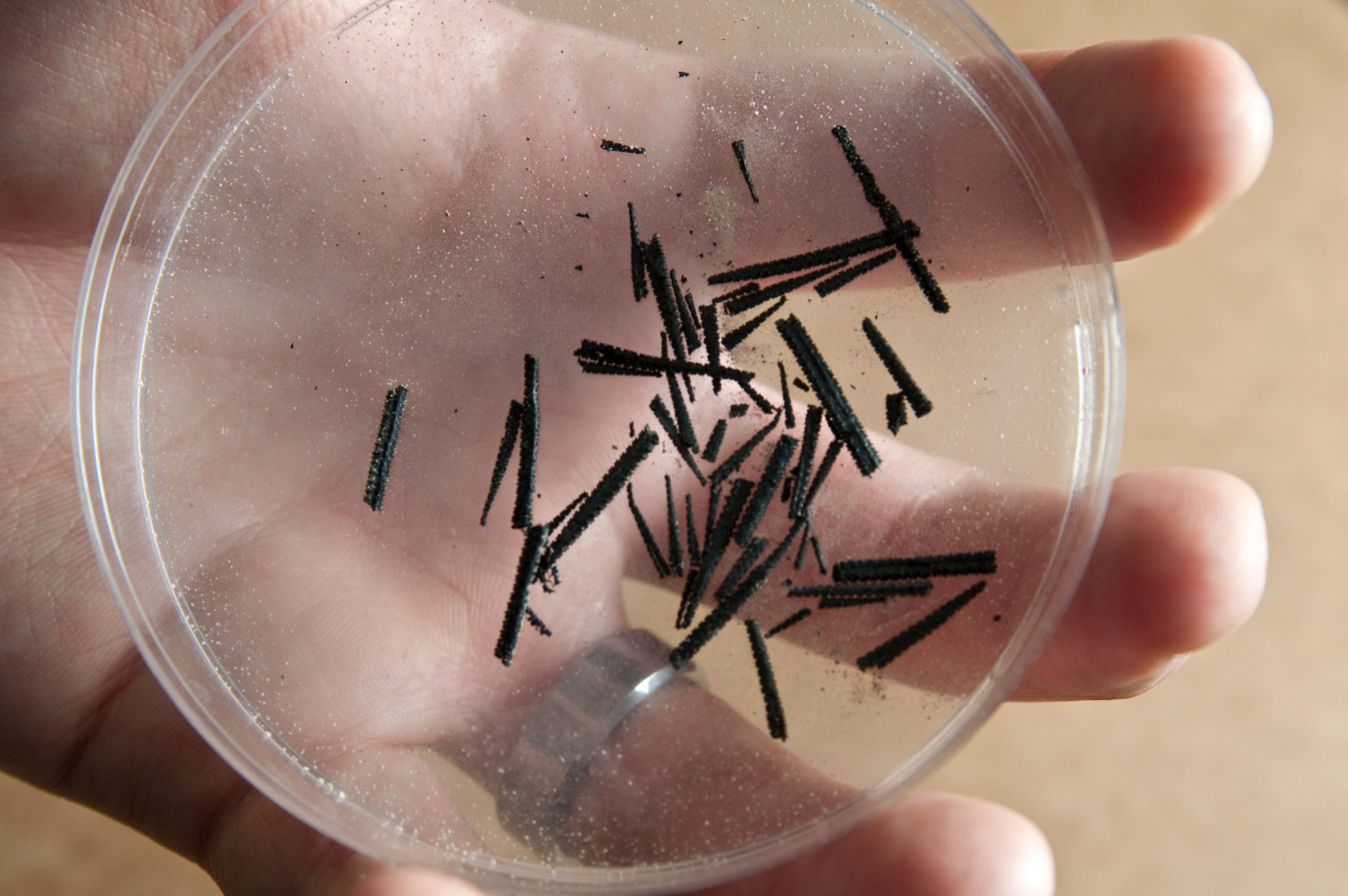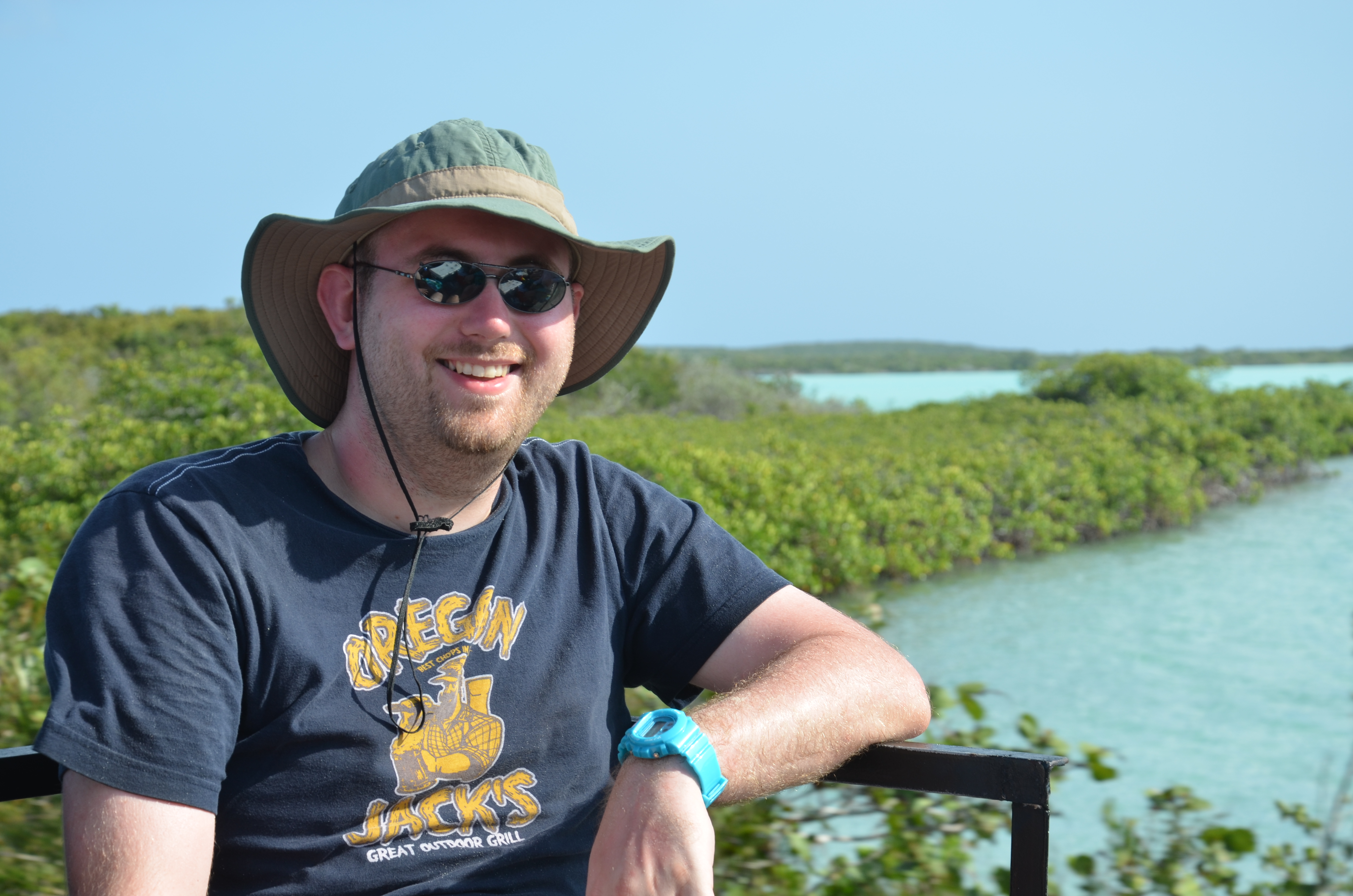Meet Dr. David W. Bapst
Learn more about one of the department's paleontologists and statistical analysts, Dr. David W. Bapst.
Dec 14, 2018
Dr. David William Bapst grew up in upstate New York, specifically western New York near Buffalo, on the shores of Lake Erie - a land of chicken wings, Bills and Sabres fanatics, and a lot of Devonian shales. He would often walk a few blocks to a creek bed behind a fire station to collect brachiopods and trilobites from the Middle-Devonian Hamilton Shale. He wasn’t really into collecting though, more just seeing how to collect fossils. Bapst was very interested in what the fossil record could tell us about the world, and how evolution worked from a very early age.
After high school, Bapst decided to go to college nearby at the State University of New York at Buffalo (SUNY Buffalo). It is a large state university, dominated by engineering - very much like Texas A&M. Although, of course, with much more snow - all the buildings are connected by tunnels and walkway bridges so you don’t have to go outside as you walk from one of campus to another. As soon as he was on campus, Bapst immediately introduced himself to the paleontologists on campus - a lab led by Chuck Mitchell, full of researchers working on the enigmatic and extinct group of Paleozoic zooplankton known as the planktonic graptolites. He was very interested already in the big evolutionary questions from the beginning, after reading Bob Bakker’s “Dinosaur Heresies” in high school, it introduced him to the weird theory known as punctuated equilibrium. In college, and through Chuck Mitchell, Bapst was introduced to Dave Raup’s “Extinction”, the work of Steve Gould (especially his early work on the evolution of development), and the troubles and trials of analyzing biological form (a field called morphometrics, as an organism’s shape is known as its morphology), and inferring evolutionary family trees (phylogenetics, which in paleontology is usually limited to inferences based on morphology).
Bapst didn’t really think he would learn to like invertebrate taxa, having grown up more familiar with vertebrate groups, but that changed. After a few years of doing vertebrate fossil collection with a few different groups, and understanding the differences between fossil records, he began to see how the invertebrate fossil record was just better for the evolutionary and ecological questions he was interested in. As an undergrad, Bapst became very interested in statistics and data analysis, and started taking courses in those areas. Those courses gave him his first exposure to computer programming. In particular, he took a class specific to data analysis in geology, a version of which he is offering here at TAMU in the spring of 2019.
Meanwhile, Bapst worked on a research project looking at the morphological change in graptolites as they went through an evolutionary bottleneck during the Late Ordovician mass extinction. That undergraduate research project eventually became his first publication. Because of this experience, he really valued the ability of undergrads to work on projects with faculty and have ownership of their undergraduate research. Of course, Bapst went on from Buffalo to apply to graduate school, particularly to major invertebrate paleontology programs, and went to the University of Chicago because they are well known for producing some of the sharpest minds in paleontological data analysis and theory.
At Buffalo, Bapst never thought he’d be a graptolite worker, but in graduate school he realized how rare it is for groups to have well sampled fossil records with incredibly precise chronological dates (graptolite biozone boundaries are dated to within a few hundred thousand years, and biozones themselves are often much less than a million years in duration), or have exquisite three-dimensional preservation (because graptolites are organic fossils, we can dissolve them as three-dimensional specimens from carbonate rock), enabling us to infer detailed information about their phylogenetic relationships. Even more so, graptolites are fascinating because there’s really nothing like a planktonic graptolite around today – graptolite colonies are constructed by the zooids in a way that is more like a communal bee hive than a body, and there’s simply no modern ecological equivalent to these tiny submersible cathedrals. How planktonic graptolites swam or otherwise maintained their position up in the water column is a complete mystery; while we realized that some groups of hemichordates (a phylum most closely related to echinoderms – sea stars, sea urchins, etc) are living graptolites, those live in tiny colonies attached to the sea floor. That we know so much about graptolites because of their detailed fossil record, and yet understand so little about what they did is something that fascinates Bapst everyday.
So, Bapst convinced his advisors at Chicago to let him work on graptolites, and from there his dissertation became focused on how we combine stratigraphic and phylogenetic data – how do we know when major groups diverged from each other? How can we best account for the uncertainties of an incomplete fossil record? How does our assumptions about when lineages speciate or go extinct impact our ability to know when a group might actually existed, and how that inform how we do biostratigraphy? Can we quantify our confidence when we infer that two fossil species are in an ancestor-descendant relationship, and if we can, what types of ancestor-descendant relationships do we infer from the fossil record? How can we best compare the differing phylogenetic relationships inferred from morphology of living taxa, versus from molecular sequences, and how can we use that information to inform how we do systematics in paleontology? These are questions that impact essentially every group of organisms, and how we might answer those questions differs from one fossil record to the next. That has led Bapst to leading groups of collaborators involving analyses of not just the graptolite fossil record, but also the early avian dinosaurs, modern articulate brachiopods, Cambrian trilobites, and many others. These questions also cannot be asked without new and better methods for analyzing our data, so he has designed and released scientific software for doing phylogenetics in the fossil record (named `paleotree`), which has become widely used in paleontology and evolutionary biology.
Bapst was a Geology BS at Buffalo, but some of the most important classes he took were electives from outside his department: several classes on statistics and probability theory, a course on linear algebra (which is the basis for multivariate statistics), as well as several courses from the philosophy department, particularly philosophy of science. Personally, Bapst sees statistics and data analysis as being very much like philosophy, primarily concerned with the metaphysical question of how we might know something – he often says that statistics is philosophy that just looks like math. That said, his background as a geologist is what makes it possible for him to have the understanding to build models of the incompleteness of the rock record, and understanding the wide breadth of stratigraphic, cyclical, and regional sampling issues that we still don’t account for in our models.
At Chicago, Bapst’s degree was a PhD in Geophysical Sciences – the GeoSci department at Chicago is a combination of paleontologists, geologists, geophysics, oceanographers and atmospheric scientists, not to mention cosmological geochemists and planetary geologists. He’d say that was really good preparation for being in our diverse College of Geosciences here at A&M. At Chicago, in seminars and journal clubs, he was always able to constantly be in the same room and interacting with ecologists, organismal biologists, geneticists, philosophers, and historians of science. That was one of the most valuable pieces of his graduate career, as it taught him how important it was in interdisciplinary work to understand the language of those other scientists that you are talking to, because so much confusion and conflict can arise because they might use the same words, but mean something totally different, or use different words to mean the same thing. There’s no way to learn those obstacles of vocabulary without being in the same room and having those interdisciplinary discussions.
Bapst’s post-doc research is focused on Approximate Bayesian Computation approaches to measuring adaptation and competition in the evolutionary history of organismal traits. The project that Bapst is most excited about is currently is a collaboration with eight other collaborators, where they are measuring the support for different types of ancestor-descendant relationships in more than thirty different groups of fossils invertebrates, mainly from the Paleozoic. This work really builds off of the research he mentioned previously about how we reconstruct evolutionary trees in the fossil record. For a long time, paleontologists have treated the question of ancestor-descendant relationships among fossil taxa as an issue that could only be treated qualitatively, because support for a particular ancestor-descendant relationship could not be quantified. Thus, the only format for talking about whether some trilobite species was a direct descendant of another trilobite species (as opposed to only referring to the two as unspecified close relatives) was to simply draw a diagram of that ancestor-descendant relationship.
Around five years ago, however, methods started to appear in the literature that allowed them to test for and measure their confidence in inferring ancestor-descendant relationships, including the cal3 method he released and published in 2013. Already in one published paper with Melanie Hopkins from the American Museum of Natural History, they found that the ancestor-descendant relationships for Cambro-Ordovician pterocephaliid trilobites closely matched those inferred by trilobite workers decades ago. This was great news for them believing their methods, because they expected that experts working based on their own domain knowledge should be able to identify the likely ancestor descendant relationships, even if those workers hadn’t quantified the morphological data or developed a precise stratigraphic age model (as Melanie has done), or were able to apply methods that considered support for different ancestor- descendant relationships.
Their results did differ from previous work in that they found little support for species of trilobites evolving into a new species of trilobite via morphological shifts (such that there was only lineage, just two different morphotaxa), as was previously argued for many of these ancestor-descendant relationships, but rather that descendants had ‘budded’ off from their ancestral species during a branching speciation event. Analyses like these are what are now expanding to datasets that include graptolites, brachiopods, more trilobites, eurypterids, crinoids, blastoids, sea urchins, and many other invertebrate groups from the fossil record. By doing large scale analysis across so many groups, they hope to understand what modes of ancestor-descendant relationships occur most often, and how their reconstruction of different types of relationships are impacted by taxonomic practice and the sampling of the fossil record.
Those interested in hearing more about graptolites can hear Bapst talk about them and his research on them in an interview he gave to Laura Soul in 2016 for the paleontology podcast Palaeocast:
http://www.palaeocast.com/episode-71-graptolites/
Additionally, Bapst gave an interview to the Royal Society about the innovations in the intersection of evolutionary biology and paleontology here, which was timed to come out with a special issue on that topic for the journal Biology Letters, that he served as a special editor for:
http://blogs.royalsociety.org/publishing/fossils-in-trees

Photos courtesy of Dr. David William Bapst.




